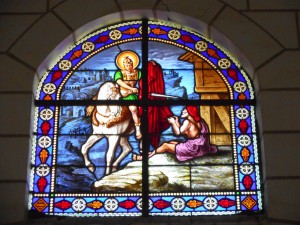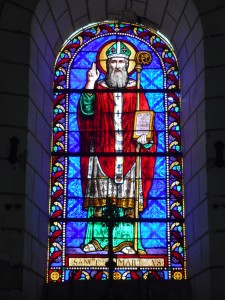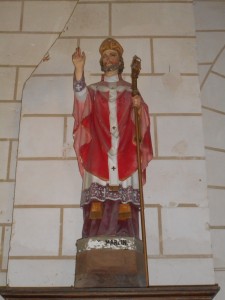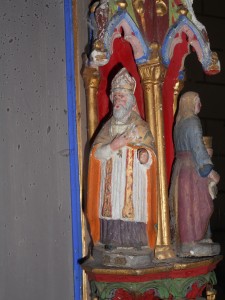La première mention de l’église est dans une bulle d’Innocent II en 1139. Mais il est certain que la fondation est plus ancienne, sûrement le Xe siècle.
la nef, dont les murs gouttereaux ont conservé une grande partie du petit appareil primitif, date probablement du Xe siècle. Le mur méridional forme l’appui de trois fenêtres en plein cintre, la troisième a été refaite et agrandie. La nef est couverte en charpente, le cinquième entrait est timbré d’armoiries.
Au XIIe siècle furent reconstruit à la place de l’abside primitive, un transept, dont le bras méridional fut surmonté d’un clocher, et une abside flanquée de deux absidioles correspondant chacune à un croisillon. Cette partie de l’église fut repris au XVe siècle, puis en 1700 et en 1761. Le carré du transept est restauré. Le croisillon nord a été reconstruit au XVe siècle et voûté d’ogives avec clefs timbrées d’armoiries. Les murs gouttereaux ont été surélevés au XVIIIe siècle.
L’absidiole nord fut reprise au XVe et au XVIIIe siècles. Sur la place qui s’étend au nord de la nef se remarque un dépositoire ou pierre d’attente funéraire plus vraisemblablement du XIIe siècle, cette pierre est parfois attribuée au XVe siècle.
L’église est classée Monument historique le 19 septembre 1966 PA00097599.
The first mention of the church is in a bull of Innocent II in 1139. But it is certain that the foundation is older, probably the 10th century.
The nave, whose gutter walls have preserved a large part of the primitive stonework, probably dates from the 10th century. The southern wall forms the sill of three round-headed windows, the third of which has been rebuilt and extended. The nave is covered with a roof frame, the fifth doorway is stamped with a coat of arms.
In the 12th century, a transept was rebuilt in place of the original apse, with a bell tower on the southern arm, and an apse flanked by two apses, each corresponding to a cross. This part of the church was rebuilt in the 15th century, then in 1700 and in 1761. The square of the transept was restored. The north cross was rebuilt in the 15th century and vaulted with ribbed keys bearing coats of arms. The eaves walls were raised in the 18th century.
The northern apsidal chapel was rebuilt in the 15th and 18th centuries. In the square to the north of the nave there is a funerary depository or waiting stone, most likely from the 12th century, which is sometimes attributed to the 15th century.
The church was listed as a historical monument on 19 September 1966 PA00097599.
Le vitrail est exécuté par les frères Guérithault de Poitiers en 1868. Martin est en légionnaire, nimbé, coupant la moitié de son manteau, rouge, pour le donner au pauvre, assis par terre, à demi nu. Le pauvre tient un morceau du manteau dans ses mains. L’arrière plan est lugubre, il représente un paysage de ruines sur un ciel très sombre.
The stained glass window was made by the Guérithault brothers of Poitiers in 1868. Martin is a legionnaire, nimbed, cutting off half of his red coat to give to the poor, sitting on the ground, half naked. The poor man is holding a piece of the coat in his hands. The background is gloomy, showing a landscape of ruins against a very dark sky.
Le vitrail est réalisé par les frères Guérithault de Poitiers en 1868. Il est disposé dans la chapelle absidiole de l’église, au-dessus du tabernacle. Martin est en évêque, nimbé et mitré, portant une chasuble rouge. Il fait le geste de bénédiction de la main droite et tient l’Évangile dans la main gauche. La crosse est appuyée le long de son bras gauche. Au bas du vitrail est écrit SANCTUS MARTINUS.
The stained glass window was made by the Guérithault brothers from Poitiers in 1868. It is located in the apsidal chapel of the church, above the tabernacle. Martin is a bishop, nimbed and mitred, wearing a red chasuble. He makes the gesture of blessing with his right hand and holds the Gospel in his left hand. The crosier is resting along his left arm. At the bottom of the window is written SANCTUS MARTINUS.
Saint Martin est représenté en évêque, il tient la crosse dans la main gauche et fait un geste de bénédiction de la main droite. Sur son socle est écrit « Martin », le reste est effacé. La statue est colorée.
Saint Martin is depicted as a bishop, holding a crosier in his left hand and making a gesture of blessing with his right hand. On his base is written « Martin », the rest is faded. The statue is coloured.
Cette statuette date du milieu du XIXe siècle. Elle se trouve sur le tabernacle du maître-autel. Le tabernacle comprend plusieurs dais surmontés de pinacles, qui abritent des statuettes, dont celle de saint Martin, représenté en habit d’évêque, mitré, avec une cape dorée, une étole rouge et dorée, une dalmatique blanche et une aube grise. Il met la main droite sur son cœur et sa main gauche semble tenir un objet qui a disparu, sans doute sa crosse. Les broderies des vêtements liturgiques de saint Martin sont particulièrement remarquables. En plus de saint Martin sont représentés la Vierge, saint Jean, les quatre évangélistes et saint Étienne.
This statuette dates from the middle of the 19th century. It is on the tabernacle of the high altar. The tabernacle has several canopies surmounted by pinnacles, which house statuettes, including that of Saint Martin, represented in the habit of a bishop, mitred, with a golden cape, a red and golden stole, a white dalmatic and a grey alb. He places his right hand over his heart and his left hand seems to be holding an object that has disappeared, probably his crosier. The embroidery on St Martin’s liturgical vestments is particularly noteworthy. In addition to St. Martin, the Virgin Mary, St. John, the four Evangelists and St. Stephen are depicted.

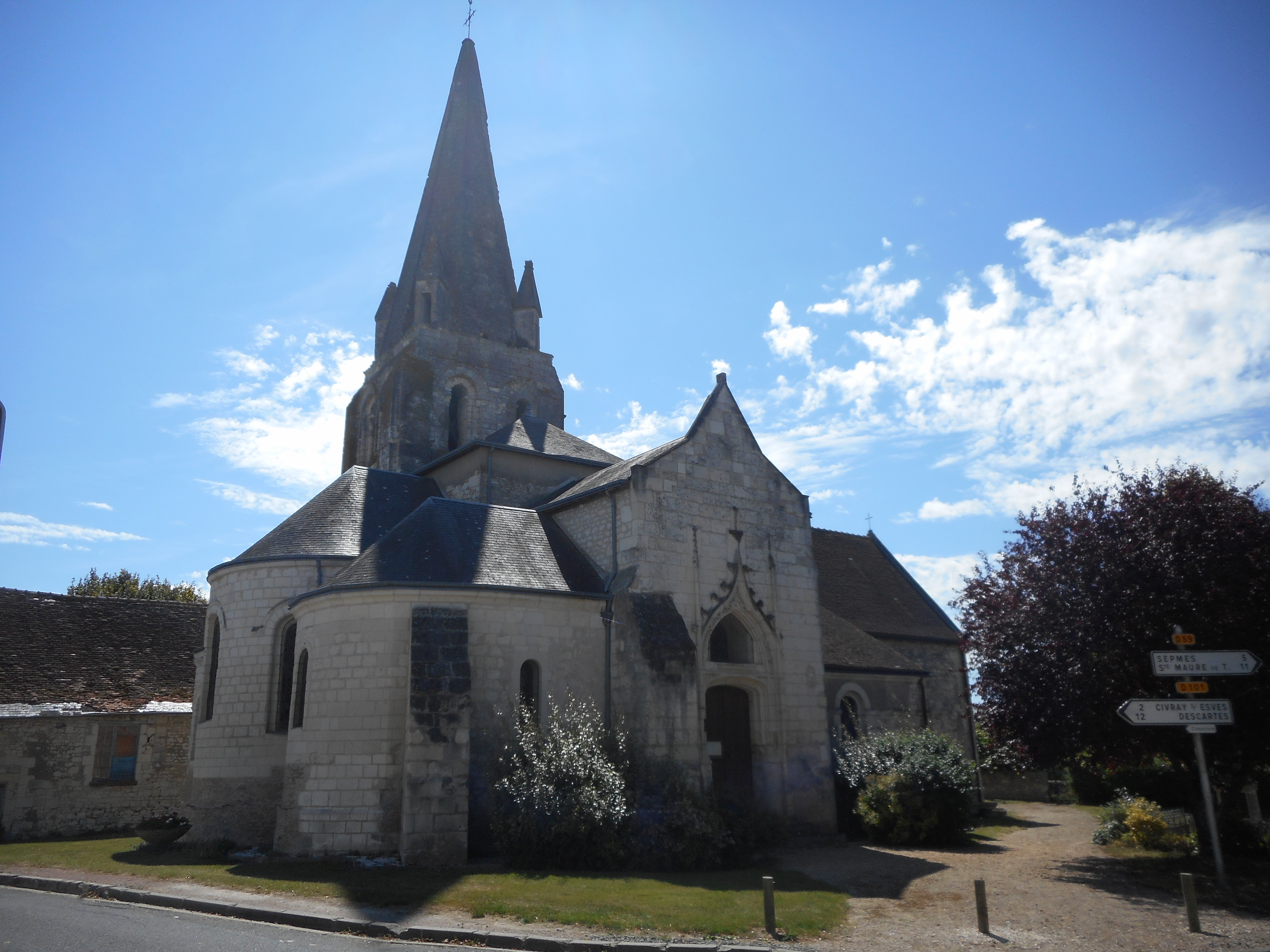 "/>
"/>
